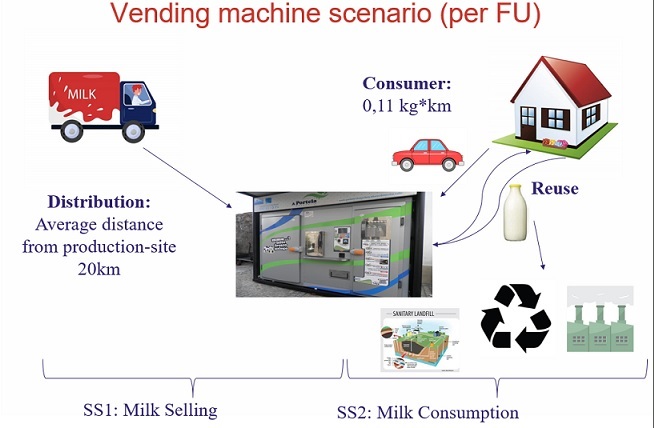
Milk Packaging
Environmental impacts of milk packaging
In the EU, 30.1 million tons of drinking milk are produced every year. Three major types of single-use packaging are used for the commercialization of milk: laminated cardboard, HDPE and PET bottles.
Less largely used packaging solutions exist throughout Europe and the world: polypropylene bags, glass bottles, etc, but were not considered here.
A first part of this case-study uses the study of Meneses et al 2012 published comparing the environmental impact of these three types of packaging and their size, taking into account the milk and packaging production, transport, and end-of-life (EOL) treatment (recycling, landfill, or incineration).
We will only discuss the production and disposal steps of the packaging. More data on other steps is available in the article.
| PET bottle | HDPE bottle | Asceptic Carton | |
|---|---|---|---|
| Main components | PET | HDPE | Carton |
| Secondary components | aluminium, LDPE |
When using a complex packaging material such as aseptic carton, there must be a guarantee on its local recyclability.
Different container size used were 0.2, 0.5, 1 and 2L. The impact indicators used were Climate Change (CC - quantified as green house gas emissions) and Acidification Potential (AP).
Results
No matter the EOL scenario, the aseptic carton has the lowest CC and AP.
The comparison of the different EOL scenarios shows that the recycling scenario is of course the most advantageous one. In that case, the differences in CC between the different materials decrease.
However, it must be considered that in the "recycling scenario" of the aseptic cardboard, only the cardboard component was taken into account. The aluminium and LDPE compounds are assumed to be landfilled. If these materials were to be recycled, the environmental advantage of the laminated cardboard would presumably be higher.
Larger packaging sizes are more advantageous, because of the more favorable packaging/food volume ratio. The 2 L laminated cardboard packaging had the lowest CC.
The study shows also that the environmental impact of the milk itself is 10 times higher than the impacts of transport, packaging production, and EOL. The impact of packaging size on generated food wastes needs to be studied carefully, because food losses can quickly out-weight the gains realized by the decrease of packaging materials. More information can by found in Williams et al. 2011, or Stankiewicz et al. 2019 and in the case-study on beef packaging.
As we saw in this study, packaging size and material choice can help limit the environmental impact of a packaging. However, if recycling is a key element to the EU's waste management strategies, reuse holds potentially even higher savings potential.
Milk packaging in short-circuit logistics
This second case study focuses on the use of reusable packaging in short-circuits. The article from Pereira et al. 2018 gives an environmental but also socio-economical analysis of the a milk distribution system using multi-use glass bottles in Galicia (Spain). We will be focusing on the results for the environmental part. The socio-economic analysis of the article explains the reasons of the impossibility to install a long-term distribution scheme based on this feasibility study and the difficulties of a transition towards short-cycle logistics and circular models faced by individual entrepreneurs.
The case study compares two distribution scenarios: distribution through a vending machine using plastic or glass bottles and distribution through a supermarket.
The study focuses on the impact of distribution and consumption of pasteurized milk (functional unit, FU, 1 L of fresh pasteurized milk). It assumes equal impacts linked to milk production and pasteurization in both scenarios.
Most articles give an overall climate change impact of 1 kg of CO2,eq per liter of pasteurized milk.
The study considered the milk supply either through the vending machine or through a local supermarket and divided the vending process for the LCA analysis in the milk selling (SS1) and milk consumption phase (SS2). The main differences among the scenarios are indicated on the following figure:

Figure 1. Milk supply through a vending machine using reusable plastic or glass bottles

Figure 2. Milk supply in the supermarket using single use plastic or glass bottles
Some elements (distance to vending machine, allocation of the transport step) necessary for the LCA were obtained through a survey.
The data of the end-of-life treatment were indexed on regional data of Galica (Spain). In particular in studies on short circuits, care must be given to the local waste-treatment environment of a packaging.
This study did not take into consideration food-wastes. This case study on meat packaging could help you in understanding the importance of lost food for the environmental assessment of a product.
Results
- The LCA showed that the vending-machine scenario had a on average 45 % reduced environmental impact in all analyzed categories. This reduction was mainly realized in the milk consumption (SS2) stage. Transport and packaging are the main processes responsible of this reduction, with transport and reuse of the bottles being the main factor. The purchase on the vending machine reached preferentially consumers with higher environmental awareness willing to use reusable shopping bags and bottles and limit transport by car.
The conclusion is that short food supply chains can help to reduce impacts when they are based on real proximity and distribution logistics are managed and organized fairly.
References:
H. Williams, F. Wikstrom, Environmental impact of packaging and food losses in a life cycle perspective: a comparative analysis of five food items, Journal of Cleaner Production, 19 (2011) 43-48. online article
M. Meneses, J. Pasqualino, F. Castells, Environmental assessment of the milk life cycle: The effect of packaging selection and the variability of milk production data, J. Environ. Manag., 107 (2012) 76-83. online article
S.K. Stankiewicz, R. Auras, S. Selke, Modeling American Household Fluid Milk Consumption and their Resulting Greenhouse Gas Emissions, Sustainability, 11 (2019) 16. online article
Á. Pereira, P. Villanueva-Rey, X. Vence, M.T. Moreira, G. Feijóo, Fresh milk supply through vending machines: Consumption patterns and associated environmental impacts, Sustainable Production and Consumption, 15 (2018) 119-130. online article